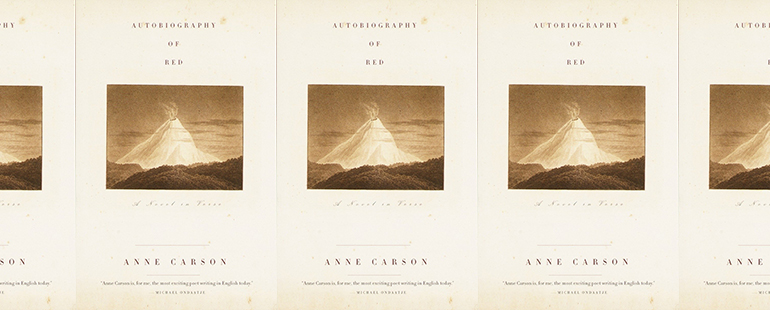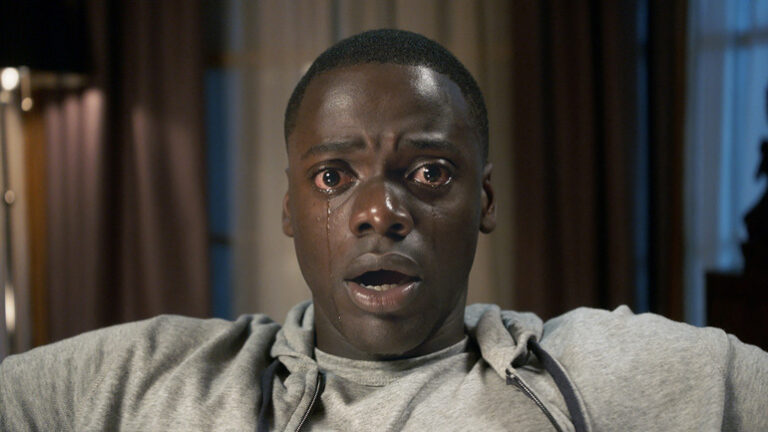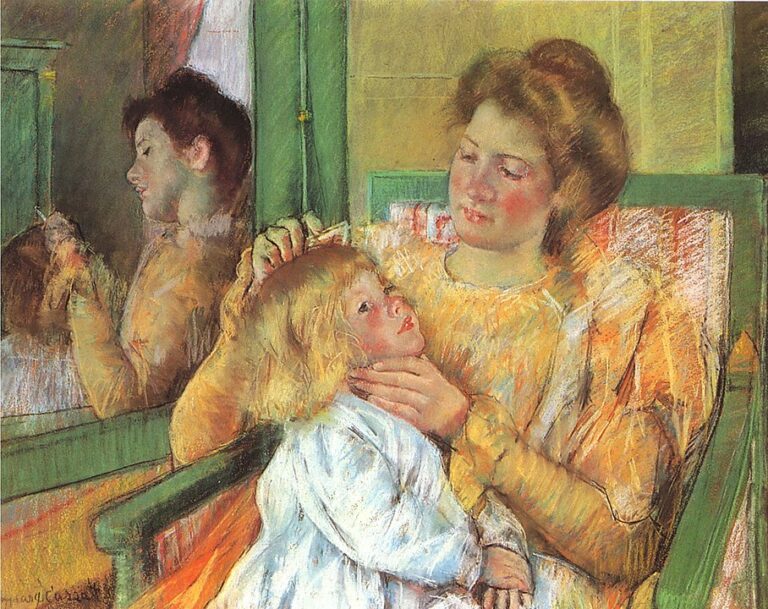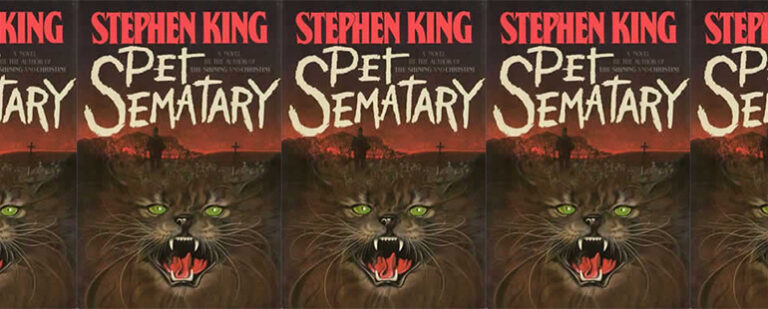Shifting Perspective in Anne Carson’s Autobiography of Red

Autobiography of Red, like most of what Anne Carson writes, is a shape-shifter. It’s a blending of modern and archaic, mythic and mundane: part queer coming-of-age novel, part reimagined fragmentary poem by the Greek poet Stesichorus. The original poem, Geryoneis, followed the life of the monster Geryon leading up to his death at the hands of Hercules. In Carson’s telling, Geryon becomes a sensitive and artistic boy of our own time, marked out by his family and peers as being monstrously non-normal. Hercules (Herakles, in Carson’s precise transliteration from the Greek) is, naturally, still rough with people, but doesn’t break Geryon’s skull—instead, he breaks his heart.
Carson spends the first few sections of her short book describing the original poet, Stesichorus—an artist, she says, with a special genius for adjectives. This is important, Carson maintains, because adjectives “are in charge of attaching everything in the world to its place in particularity. They are latches of being.” Stesichorus used his newly minted, anti-Homeric descriptions to “release being.” In keeping with her muse, Carson’s novel is driven by unlatching being, too: Geryon’s narration progresses from the self-absorption of childhood through adolescence and into the comparative wisdom of young adulthood. Along the way, Carson shows this journey primarily through changes in the way that the outside world, and those who live in it, are observed.
To inhabit one’s self, one must learn to see a larger, selfless world. Autobiography of Red moves through Geryon’s coming-of-age in fluid verse, using a third-person narration that is almost always at a close psychic distance and which transitions from innocent narcissism to the capacity to speak beyond itself. In Geryon’s childhood, the personal self is paramount. Details about the world are almost never mentioned—or, if they are, they are described in the context of how they appear to Geryon. In a scene describing the layout of his school, we read: “Between Main Door and Kindergarten ran a corridor. To Geryon it was / a hundred thousand miles / of thunder tunnels and indoor neon sky slammed open by giants.” The outside world is strange, and older children are giants—barely human. There is no attempt to characterize anyone who isn’t already known. At home, on the other hand, where everything is familiar, Geryon seems to be a gravitational center. When Geryon feels ashamed at his brother’s reminder that he does not know how to tie his shoes, “The fruitbowl paused. Geryon could in fact tie knots but not bows.” Even the inanimate world moves in step with Geryon’s thoughts.
Geryon’s adolescence is characterized by the awkward meeting of this self-absorbed child and details of the Other and the outside. Observations of the world and space are more frequent and more complex than in childhood. “It had rained suddenly at suppertime, / now sunset was startling drops at the window. Stale peace of old bedtimes / filled the room.” But these observations belong, very firmly, to a self. The stale peace is Geryon’s own, no one else’s. Geryon begins, at times, to guess at the experiences of imagined others: “What is it like to be a woman / listening in the dark?” But adolescence brings the first real moments of shared perspective, too. When Geryon, fourteen, meets Herakles for the first time, disembarking at a bus station, “The world poured back and forth between their eyes once or twice. Other people / wishing to disembark the bus from New Mexico / were jamming up behind Herakles.” Geryon’s perspective widens here, beyond the childish limits of self. But still it’s selective. His eyes are shutting certain people out.
We can’t help but fall in love with the people into whose eyes we first pour our world, and this is what Geryon does. He shares his perspective with Herakles, and they spend all evening talking. As Geryon begins to share his view of the world, he also takes up photography. The controlled, manipulated relationship with perspective that comes from being a photographer follows naturally from Geryon’s adolescence, and his falling in love with the world. “‘How does distance look?’ is a simple direct question. It extends from a spaceless / within to the edge / of what can be loved. It depends on light.” Of course, when we lose our first love, it’s often because there was something just beyond that horizon, just past the corner of our eye, where the light of love didn’t reach. There’s always something we’re ignoring. We think that all of our world-pouring means that our lover now shares our views completely, our hopes and our plans, but this is not always the case.
There are usually alarms before a relationship implodes, heeded or not, and so it is for Geryon. One day, when he and Herakles are out making graffiti, Herakles tells Geryon that his designs are too depressing. Herakles asks him to do something more cheerful and Geryon “watched the top of Herakles’ head / and felt his limits returning. Nothing to say.” Later, Herakles’ grandmother warns Geryon, “I think you are confusing subject and object.” But still, the eventual abandonment comes as a surprise. Herakles sends Geryon packing without discussion, gives him a version of, “We can still be friends,” and it’s over.
But adolescence ends, too, and young adulthood shows us Geryon’s burgeoning ability to see himself as existing in a story of many others. While the narration remains in the close third, certain observations belong more ambiguously to one character or another. In an airplane, travelling alone, Geryon experiences “Staring at the vast black / and silver nonworld moving / and not moving incomprehensibly past this dangling fragment of humans.” Geryon becomes, for this moment, one among many observers.
This widening of perspective develops through his meeting a new lover, Ancash, and comes to a climax at the very end of the text, where seven of the eight final chapters are introduced in a distant third, via descriptions of photographs that Geryon has taken. There is a picture of four people at a table, of two burros grazing, of a roasted guinea pig on a plate. In none of these does Geryon appear; he’s always just out of frame. But they are central to his story. We see that he has come to understand himself as a single observer who exists within a larger world, a larger body of perspectives, all of them simultaneous. Photography has helped him work this out, surely, but so has the unavoidable act of growing up.
Through first withholding and then granting the narration’s use of details external to Geryon’s inner experience, Carson makes it clear that Geryon’s journey of self-discovery is, in part, a journey towards seeing the self as one among other selves. The mature observer is the one with the power to lose oneself in the alternate perspectives. Carson’s ultimate zoom-out is the one that has been there from the beginning, even in Geryon’s earliest self-image. It’s the very frame of the book: autobiography via mythic metaphor. This spreading of consciousness allows Geryon to see himself as a part of history and myth. That tendency of ours—to see ourselves as part of a story extending beyond the lived-in era—can be self-aggrandizing. But, when trained, it can also be vital to an immortal universality, and to taking the widest possible perspective. We learn, finally, to say not just I am Geryon, or He is Herakles but also she will be, they were, we all are.


